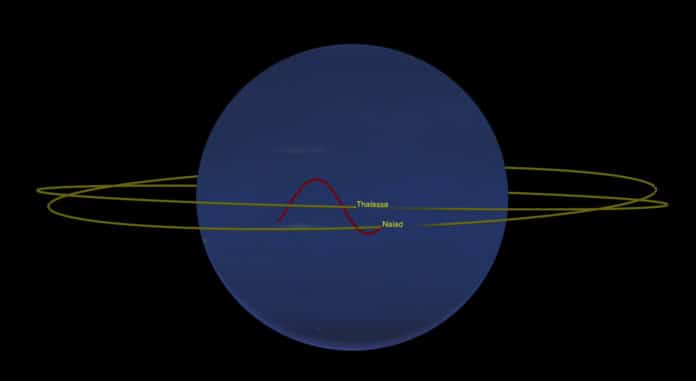Neptune is the eighth and farthest known planet from the Sun in the Solar System. It has 14 named moons. In 1989, Voyager 2 discovered Neptune’s two innermost moons Thalassa and Naiad, that are tiny and also known as moonlets.
Recently, These two moons orbit only about 1,150 miles (1,850 kilometers) apart. But they never get that close to each other. Recently, the moons are found to be locked in ‘dance of avoidance.’
Naiad swirls around the ice giant every seven hours, while Thalassa, on the outside track, takes seven and a half hours. An observer sitting on Thalassa would see Naiad in an orbit that varies wildly in a zigzag pattern, passing by twice from above and then twice from below. This up, up, down, down pattern, repeats every time Naiad gains four laps on Thalassa.
Marina Brozovic, an expert in solar system dynamics at NASA’s Jet Propulsion Laboratory in Pasadena, California, said, “We refer to this repeating pattern as a resonance. There are many different types of ‘dances’ that planets, moons, and asteroids can follow, but this one has never been seen before.”
Naiad and Thalassa are small and shaped like Tic Tacs, spanning only about 60 miles (100 kilometers) in length. They are two of Neptune’s seven inner moons, part of a closely packed system that is interwoven with faint rings.
Scientists discovered unusual orbital patterns using analysis of observations by NASA’s Hubble Space Telescope. The work likewise gives the principal insight into the interior composition of Neptune’s inner moons. Scientists utilized the observations to register their mass and, thus, their densities – which were close to that of water ice.
Mark Showalter, a planetary astronomer at the SETI Institute in Mountain View, California, said, “We are always excited to find these co-dependencies between moons. Naiad and Thalassa have probably been locked together in this configuration for a very long time because it makes their orbits more stable. They maintain peace by never getting too close.”
